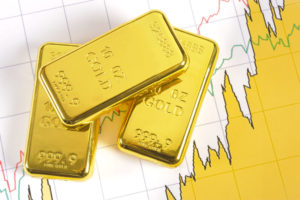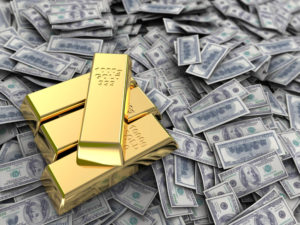The headlines earlier this week had gold hitting eight-year highs. Futures prices nearly topped $1,800 for the first time since the 2012 relief rally after the September 2011 peak.
The broad fundamentals for gold are lining up for a big rally into the first half of this decade (in fact, M&M Chief Investment Strategist Adam O’Dell says gold is going to $10,000).
The financial system is fundamentally broken. There are leaky pipes in the plumbing of markets all over the world.
Right now, central banks are doing their best to patch these leaks, but the outflow is just too great. And the stock market is still in a state of denial that the world we used to know is gone.
The Rules of Society Are Changing Under Our Feet
 A medical police state is emerging to exacerbate a financial crisis that is atomizing confidence in the central banks. Our political institutions are under furious assault from people rightfully angry by a combination of failed leadership and the gnawing sense that promises made will not be promises kept.
A medical police state is emerging to exacerbate a financial crisis that is atomizing confidence in the central banks. Our political institutions are under furious assault from people rightfully angry by a combination of failed leadership and the gnawing sense that promises made will not be promises kept.
This goes far beyond any of President Donald Trump’s campaign pledges. This is far more existential than that.
The political landscape in the U.S. is the worst it has been in nearly 160 years. There is a growing realization that the divisions between red states and blue states are unbridgeable.
It’s clear to me that actions taken by some mayors and governors, like Jenny Durkan in Seattle and Bill DeBlasio in New York, are part of a greater strategy to weaken the country internally with the hope of destroying Trump’s chances of reelection by putting him in a series of no-win situations.
When I look at this in the greater context of demand destruction, mortgage delinquencies, falling tax receipts, mass unemployment and unpayable pension system shortfalls, the only scenario I see is endless rounds of both fiscal and monetary stimulus to keep the illusion of a solvent system alive.
The truly scary part is that what the U.S. is experiencing is a microcosm of what’s happening worldwide.
So as we approach the end of June, it is no wonder that gold is pushing the envelope to the upside.
People are buying guns at an enormous rate in the U.S. right now. Gold sales to retail investors are also strong.
SPDR Gold Trust (NYSEARCA: GLD) has seen more than $15 billion in inflows in 2020 so far, a 30% increase in assets under management. It represents the highest portion of gold demand increase so far this year.
Central bank buying to this point has been muted relative to 2019 levels even though, according to the World Gold Council, there is increased interest across central banks for wanting to add gold to their reserves.
But central banks have been fighting dollar demand, which has kept their gold buying limited. That may change as the amount of dollar swaps made by the Fed with foreign central banks has finally begun to fall (see chart).

Two weeks ago, it looked like we were headed for another crisis as outstanding repos (red line) were rising against the backdrop of high central bank swaps (black line). Since then, those emergency additions to the Fed’s balance sheet have dropped considerably, giving the illusion that all is well right now as we come into the end of the second quarter.
Gold rose sharply during this period of monetary unrest after an initial sell-off with the rest of the markets in early March. The rally has been impressive and is due for some bumpy times.
So I’m not surprised as we close this week to see gold backing off considerably from its mid-week, headline-making high.
But at the same time, the U.S. dollar is quietly strengthening because the Fed didn’t give the markets what they wanted, which was negative rates. Moreover, the Senate is balking at more stimulus spending, with Majority Leader Mitch McConnell, R-Kentucky, playing at being a fiscal conservative now that Trump is under a real multi-pronged attack.
Rising Dollar Puts Gold in an Interesting Position
 There is a strong probability that the dollar will continue strengthening until the next big Fed statement, which will come from Jackson Hole, Wyoming, at the annual convocation of central bankers.
There is a strong probability that the dollar will continue strengthening until the next big Fed statement, which will come from Jackson Hole, Wyoming, at the annual convocation of central bankers.
This puts gold in an interesting short-term position fundamentally.
Because if there is an easing of monetary tensions, similar to what we saw in January and early February, gold will struggle against a rising dollar. But once that rising dollar causes another seizure in the market’s plumbing, which is inevitable, then gold will first sell off alongside everything else in a huge sell-everything-for-dollars event just like we saw in early March after oil collapsed.
But at the same time, gold is in an interesting technical position. It could end June with the highest quarterly close in its history trading against the U.S. dollar. That number is $1,771.10, set in September 2012.
However, the highest monthly close was $1,828.50, established in August 2011 just before the all-time intraday high above $1,900 in September.
A mild rally between now and the end of the month on Tuesday, June 30, could see gold hit that high quarterly closing target of $1,771.10. That would signal that the long-term bull market is not only in full swing but could even accelerate. Meanwhile, gold struggles within the more narrow technical picture at a monthly level because of short-term dollar volatility.
Remember, gold is constantly being tossed back and forth between its long-term fundamentals as a safe-haven asset, hedging government instability and short-term fundamentals as a liquid way to get access to dollars.
Taking all of this together, what I’m seeing right now is the potential for a short-term sell-off that puts a lot of bears on the wrong side of the trade, thinking the dollar is toast.
That would set up gold’s first real attempt at the $2,000 handle before the end of the year as the central banks then fire the next rounds out of their monetary bazookas, spurring the same behavior from investors we saw in Q2.
• Money & Markets contributor Tom Luongo is the publisher of the Gold Goats ‘n Guns Newsletter. His work also is published at Strategic Culture Foundation, LewRockwell.com, Zerohedge and Russia Insider. A Libertarian adherent to Austrian economics, he applies those lessons to geopolitics, gold and central bank policy.




